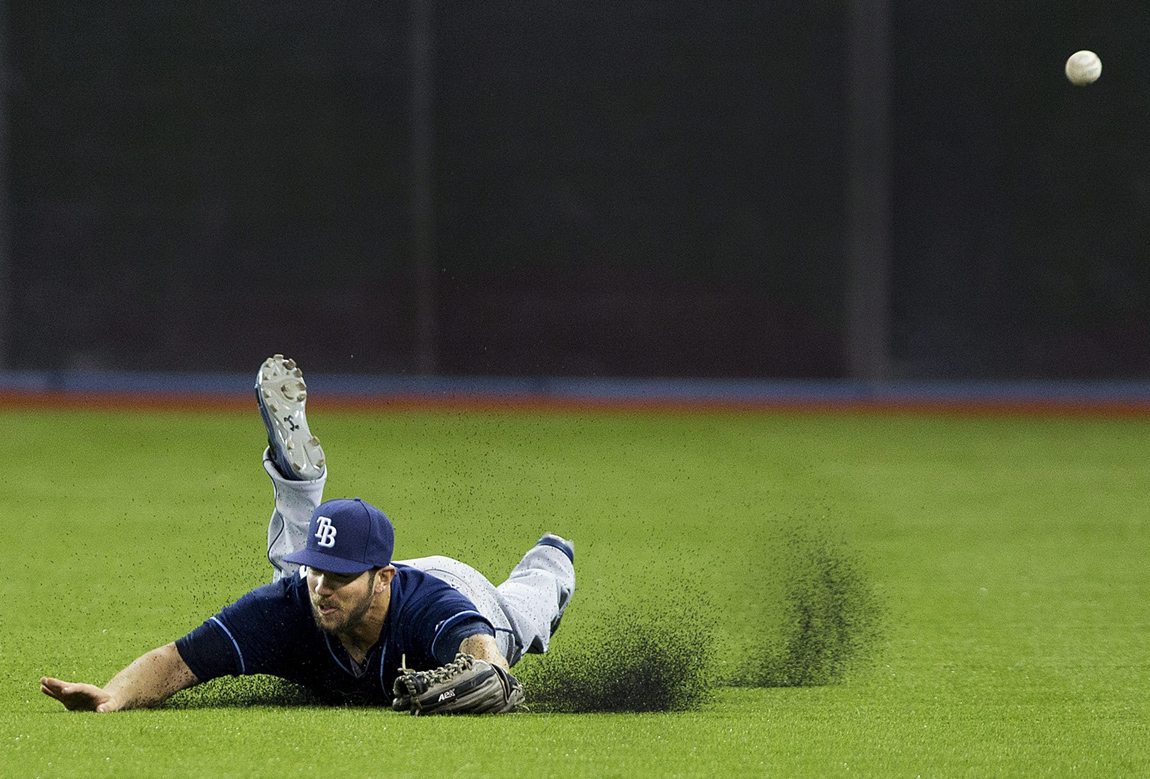Spectators at the Toronto Blue Jays’ home opener might have noticed something different about the field Monday night: the shower of black bits of rubber thrown up as players dove for the ball, for example. Or the fleck of rubber that got stuck in Tampa Bay shortstop Asdrubal Cabrera’s eye.

There’s new AstroTurf at the Rogers Centre, and it’s a bit different from the old artificial turf that was there.
“It’s comfortable. It’s like a cushion. Probably good for the knees,” said Jays catcher Russell Martin before the game. “Probably a little bit slower so it’ll be good for our pitchers and stuff.”
Jose Bautista told Sportsnet that the new turf is so slow that, “It feels like there are no balls that are going to get to the wall.” He also feels a bit slower running on it, and said the balls don’t bounce as much or roll as far.
“If it stays full and plush and slow like that, you’re going to see infielders able to make more plays on balls, especially up the middle,” said Toronto pitcher R.A. Dickey.
The turf was designed to be slower, said Kenny Gilman, vice-president at AstroTurf, the turf’s manufacturer. “I believe some folks in the team’s management wanted a slower, softer field. We built it in conjunction with their desires and wishes. It is a little slower and softer,” he said.
“It’s probably playing as slow as it ever will. It should speed up a little bit over time.”
The reason why has to do with the newness of the field, and how it is made.
The field consists of 88 panels of artificial turf, which can be rolled up and stored away when other events are held at the Rogers Centre. Each panel is made of a number of layers. There is a backing layer, then a layer of plastic “grass” fibres.
“It’s basically like a shag carpet, two inches long, flopping about,” said Gilman. To prevent that flopping but still provide a soft surface, a layer of sand or “crumb rubber” – tiny bits of black rubber usually recycled from old tires – is applied on top of the grass and between the blades “to basically mimic earth and support the grass blade and hold it upright,” he said.

That crumb rubber is what spectators saw fly into the air as Tampa Bay Rays right fielder Steven Souza Jr. dove for the ball on Monday night. Another layer of fibres helps to hold the rubber in place, “but because it’s loose, granular material, you can never totally eliminate that,” said Gilman.
“But over time, as the crumb rubber settles in and the field gets more use, there should be less, we call it in the industry ‘infill splash’. That should minimize over time.”
The last bit of crumb rubber (150,000 pounds of it) was only applied last week, he said, so it hasn’t had time to settle.
“It takes a little bit of time, could be a month or two, for the infill to work its way down, right to the base of the carpet.”
The old field had both sand and crumb rubber applied on top of the grass. In order to make the turf lighter and easier to pull up as needed, this new field only has rubber. And although sand also gets kicked into the air during play, it’s less visible than the black rubber, he said. He believes the spray is due to the newness of the material, not the lack of sand.
When the Rogers Centre wants to change the field, they use heavy machinery to roll up the strips of turf, crumb rubber and all, and store them away. Each roll can weigh up to 7,000-8,000 pounds depending on its length, said Gilman. When the Jays are ready to play again, the turf is rolled back out, stuck together along the edges with Velcro, then brushed to smooth out the turf and rubber.
“When it’s unrolled, the rubber is uniform for the most part, but it does need to be brushed and the infill levelled.”
“It’s really a one of a kind unique installation,” said Gilman. He can’t think of another field which has turf quite like the Rogers Centre.


Comments